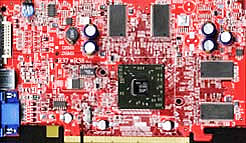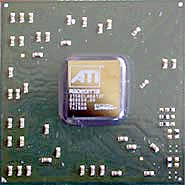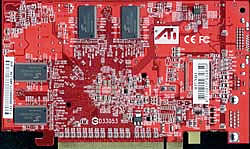PowerColor X300
2. A closer look
02 - A closer look
| Main Features | |
| GPU | Radeon X600 - R370 |
| Memory | 256 MB 128-bit DDR1 |
| Memory Speed | 400MHz |
| Core Speed | 325MHz |
| AA Sample per Sec | 7.8 |
| Memory Bandwidth | 6.4 GB/sec |
| Pixel Pipelines | 4 |
| Shader Pipelines | 2 |
| Fill rate | 1.3 Giga pixels /sec |
| DX Support | 9.0 |
| OpenGL Support | 1.5 |
| Output | DVI-I / TV-Out / D-Sub |
| Bus | PCI Express |
| Processing technology | 0.11 micron |
As we mentioned earlier, the Powercolor X300 features 256MB of DDR1 RAM, which might seem impressive to some for a low-budget card but it's a common mistake, to opt for one VGA card over another based purely on the amount of memory. What is more important is the chipset, the memory bus interface (which in our case is 128 bits wide where high end cards normally have 256 bits), plus the fact that the memory is DDR1 and not DDR3. The memory modules are from Mosel Vitelic which might not be such a high quality choice but contribute to the card's relatively low price.
 |
| A close-up of a memory module. |
The X300 fully supports DirectX 9 which means you can at least run all your favourite games with approximately the same amount of detail as an X800 would provide.
The strange thing with the X300 is that beginning with this card, ATi decided to introduce the first GPU chipset built using 0.11 micron manufacturing technology. This makes the card very resistant to overheating making it potentailly a good candidate for overclocking.
 |
| The only heat protection on the X300 is a small plastic fan. |
The card sports a red coloured PCB with it's board layout being
the same as ATi's reference. There's nothing on the card to give away its
brand, however we can see some markings indicating the card's 256MB
memory and R370 architecture.
 |
| Removing the fan and heatsink leaves the GPU exposed (click to enlarge) |
 |
Zooming in on the chipset
|
 |
| Hard to do with the naked eye but with a litle more zoom and you can read the X300 and PCI-Express label. |
 |
| The rear side of the X300 (click to enlarge) |

















